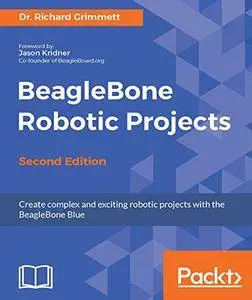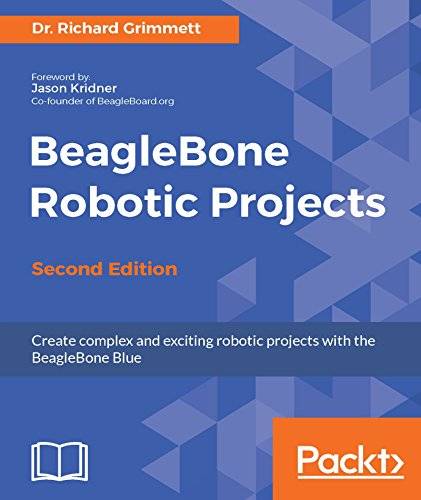by Dr. Richard Grimmett
English | 13 Jun. 2017 | ISBN: 1788293134 | ASIN: B0722QNJC2 | 230 Pages | AZW3 | 8.84 MB
English | 13 Jun. 2017 | ISBN: 1788293134 | ASIN: B0722QNJC2 | 230 Pages | AZW3 | 8.84 MB
Key Features
Build powerful robots with the all new BeagleBone Blue
Communicate with your robot and teach it to detect and respond to its environment
Control walking, rolling, swimming, and flying robots with your iOS and Android mobile devices
Book Description
BeagleBone Blue is effectively a small, light, cheap computer in a similar vein to Raspberry Pi and Arduino. It has all of the extensibility of today's desktop machines, but without the bulk, expense, or noise. This project guide provides step-by-step instructions that enable anyone to use this new, low-cost platform in some fascinating robotics projects. By the time you are finished, your projects will be able to see, speak, listen, detect their surroundings, and move in a variety of amazing ways.
The book begins with unpacking and powering up the components. This includes guidance on what to purchase and how to connect it all successfully, and a primer on programming the BeagleBone Blue. You will add additional software functionality available from the open source community, including making the system see using a webcam, hear using a microphone, and speak using a speaker.
You will then learn to use the new hardware capability of the BeagleBone Blue to make your robots move, as well as discover how to add sonar sensors to avoid or find objects. Later, you will learn to remotely control your robot through iOS and Android devices. At the end of this book, you will see how to integrate all of these functionalities to work together, before developing the most impressive robotics projects: Drone and Submarine.
What you will learn
Power on and configure the BeagleBone Blue
Get to know Simple programming techniques to enable the unique hardware capabilities of the BeagleBone Blue.
Connect standard hardware to enable your projects to see, speak, hear, and move
Build advanced capabilities into your projects, such as GPS and sonar sensors
Build complex projects that can fly, or go under or on the water
About the Author
Dr. Richard Grimmett has been fascinated by computers and electronics from his very first programming project, which used Fortran on punch cards. He has bachelor's and master's degrees in electrical engineering and a PhD in leadership studies. He also has 26 years of experience in the radar and telecommunications industries, and even has one of the original brick phones. He now teaches computer science and electrical engineering at Brigham Young University, Idaho, where his office is filled with his many robotics projects.
Table of Contents
Getting Started with the BeagleBone Blue
Programming the BeagleBone Blue
Making the unit mobile: Controlling Wheeled/Tracked Movement
Avoiding Obstacles Using Sensors
Allowing the BeagleBone Blue to See
Providing Speech Input and Output
Making the unit very mobile: Controlling Legged Movement
Using a GPS Receiver to Locate Your Robot
By Land, Sea, and Air
System Dynamics



